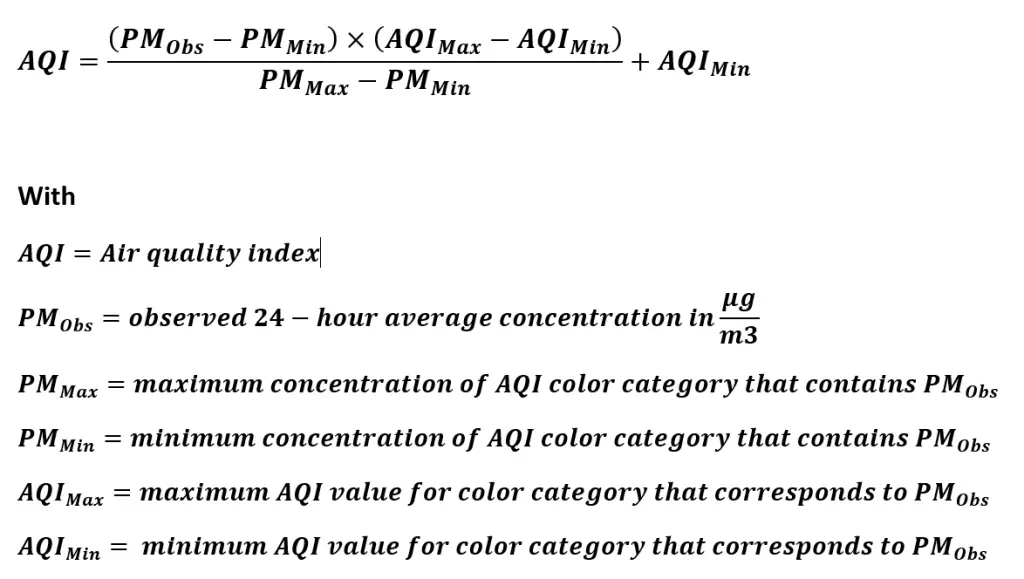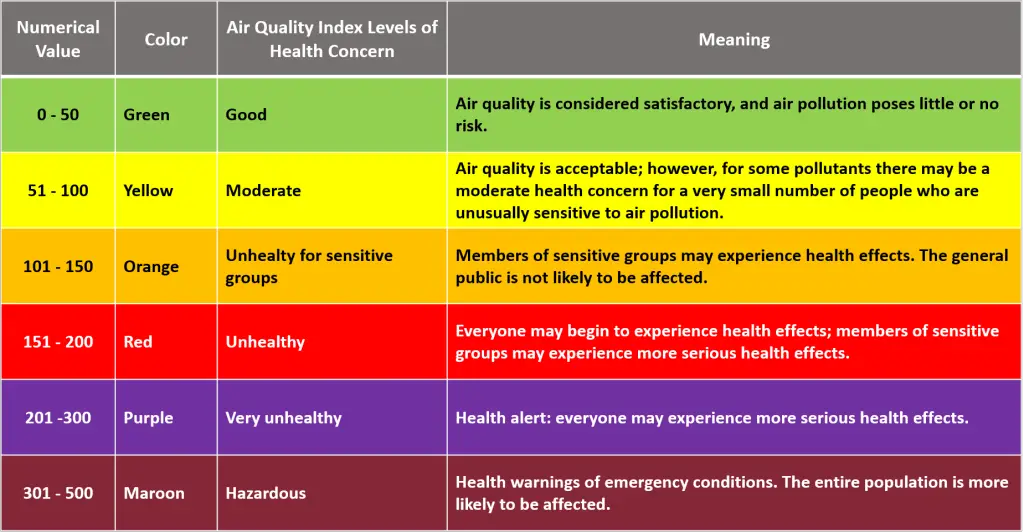“The health effects of air pollution imperil human lives. This fact is well-documented.”
Eddie Bernice Johnson, Politician
What Is Air Quality?
Air quality can be defined as the cleanness of air which is determined by the pollution level.
Low levels of air quality and thus high levels of air pollution lead to an increase in public health issues.
Especially in regions with high population density, air quality is usually quite bad.
This also visually manifests in the form of smog over big cities.
In this article, it is explained in detail how air quality can be measured and what strengths and weaknesses are implied by using these measures.
Moreover, the causes, effects and solutions for the air pollution issue are examined.
Audio Lesson
Contents
How can Air Quality be measured?
There are several different indices of air quality depending on the respective country.
These measures differ in computation and also in their level of accuracy.
The different indices also have different thresholds when it comes to determining potential health issues relating to certain concentrations of pollution.
The most popular index is the air quality index used in the United States of America developed by the United States Environmental Protection Agency.
Definition of the Air Quality Index (AQI)?
The air quality index is a measure in order to determine the level of air pollution and therefore the implied air quality in the U.S.
The AQI is divided into six categories.
The lower the AQI, the better the air quality is. An AQI below 50 indicates quite good air quality while an AQI over 300 means that the air contains hazardous concentrations of harmful substances.
How is the Air Quality Index calculated?

Meaning of the different levels of the AQI

Strengths of the Air Quality Index
- Straightforward and easy to calculate
- Easy to communicate
- AQI may help people to protect their health
Straightforward and easy to calculate
The calculations underlying the AQI are pretty straightforward and easy to execute.
Authorities only need a few variables in order to be able to calculate precise numerical values and thus to determine the air quality.
Easy to communicate
Since the color code is quite easy to understand, the AQI makes it is easy to communicate potential dangers to the public.
For example, authorities can educate the public about the different colors of the API and the meaning behind them.
For instance, when the government announces red, purple or maroon, people can easily recognize that there are severe implied health risks and can stop their children from playing outside until the danger is over and air quality has improved.
AQI may help people to protect their health
The AQI may contribute to an increase in health levels since people can be warned early and can take protective measures against the polluted air.
This may include wearing masks for the protection against particle pollution or to avoid being outside for a long period of time if air quality is quite bad.
Weaknesses of the Air Quality Index
- Dissemination to the public
- Is color really key?
- Thresholds may be subject to discretion
Dissemination to the public
Although the quality air index is easy to communicate to the public in theory, there may be some issues for communicating it in practice.
People may get quite anxious if they hear about code red regarding the AQI and may panic.
They may also refrain to leave their houses even if there likely is no immediate threat to their health. People are usually quite sensitive when it comes to information relating to their health.
An incautious form of communication may therefore lead to adverse effects on the public, even if there are no significant health threats.
Is color really key?
As humans, we like visual indications.
This is the reason why for thresholds in indices, several different colors are used to display the severeness of a threat.
However, in the AQI, colors are used in a little bit confusing way.
People usually red with the highest level of threat.
However, in the AQI, red only indicates a medium level of health risk. Purple, on the other hand, relates to the most dangerous state for human health.
If people do not know the AQI, they may conclude that there is a high danger when the red color is announced but may not be that concerned when the purple color is announced by authorities.
This may lead to incorrect decisions and may put peoples’ health at risk since they may take inappropriate actions in order to deal with different color announcements.
Thresholds may be subject to discretion
The thresholds set in the AQI may be subject to big levels of discretion.
Although they may give a rough indication of how different AQI numbers may affect inhabitants, individuals may react quite differently since some individuals are far more sensitive to air pollution than others.
Thus, states with yellow or even green levels in the AQI may cause health issues for people that are overly sensitive.
Therefore, the AQI gives a rough estimation of the adverse health effects but it should not be regarded as a sophisticated tool which is suitable for determining the effects of air pollution on every individual person.

What Affects Air Quality?
- Wildfires
- Dust
- Volcanoes
- Animals
- Radioactive decay
- Vegetation
- Vehicles
- Aircraft
- Marine vessels
- Military
- Waste deposition
- Fossil fuels
- Agriculture
- Mining
- Private households
- Industry
Wildfires
Wildfires are often caused by human behavior, for example by the incorrect disposal of cigarettes.
The danger for wildfires is especially severe in areas with dry climate.
There are some cases where wildfires are also started intentionally in order to get more land for farming or housing purposes.
For instance, in the Amazon Rainforest, it is quite common to burn down large areas of forest in order to get more space for farming.
Wildfires can cause smoke and also the emission of carbon monoxide which in large concentrations can lead to serious health conditions.
Dust
Dust is often emitted through natural processes, usually in areas with little or no vegetation.
It is composed of fine particles which can cause lung issues if concentrations are too high.
Volcanoes
Volcanic activity can lead chlorine, sulfur and ash particulates to enter the air.
Through eruptions, large amounts of those substances are released into the air which may even lead to temporary flight stops in the respective area.
Animals
Animals produce methane in their digestion processes.
The emission of methane causes air pollution and therefore also contributes to global warming.
Although the largest part of methane emission can be attributed to livestock from domesticated farming, a fraction of methane emissions also occurs from wild animals.
Radioactive decay
Radon is a radioactive element that is produced in the process of natural decay and therefore naturally occurs inside our earth.
From there, it can reach our groundwater and eventually also our air.
In higher concentrations, Radon is considered to be a serious health hazard.
Vegetation
Our vegetation system emits large amounts of volatile organic compounds that react with nitrogen-oxides and sulfur-oxides which in turn can lead to an increase in ozone levels.
Vehicles
Emissions from cars and other vehicles increase the levels of CO2 and other greenhouse gases in the air and therefore increase the global warming process.
In our Western society, it is quite common that almost every one of us owns at least one car.
Especially in suburbs or in rural areas, people rely on their cars since they have to commute to work and back.
However, even in areas where there are good public transport connections, people are usually more likely to use their cars because it feels more convenient to them.
Aircraft
Aircraft is a big cause of air pollution.
Airplanes emit large amounts of carbon dioxide and nitrogen dioxide. CO2 is known as a harmful greenhouse gas which enhances the process of global warming.
Especially in the last decades, the number of flights has increased significantly since flights have become cheaper relative to the average income levels.
More and more people are traveling to foreign countries to spend their vacations.
Moreover, many people also use the plane for business purposes.
Therefore, the number of flights worldwide and thus the level of air pollution from aircraft increased substantially over time.
Marine vessels
Marine vessels often use fossil fuels and in turn emit many harmful gases.
These include carbon dioxide, nitrogen oxides and sulfur dioxide.
These gases are harmful to public health and also contribute to global warming.
Military
Rocketry, toxic gases and nuclear weapons may also be a source of air pollution.
Many countries test weapons quite frequently, either to threaten other countries or also for training and research purposes.
Through this testing, harmful substances can be released into the air, which may result in air pollution and other adverse effects on the environment.
Waste deposition
Through the deposition of waste in landfills, large amounts of methane are produced.
Methane even has a much higher global warming potential than carbon dioxide and thus is considered one of the most harmful greenhouse gases.
However, the overall worldwide amount of methane emitted into our atmosphere is relatively small compared to the amount of CO2.
Therefore, CO2 can still be considered the most harmful greenhouse gas when it comes to absolute terms.
Fossil fuels
Fossil fuels are used in the production process of energy and for several other products.
Moreover, vehicles like cars, trains, planes and ships are highly dependent on fossil fuels.
Since in our nowadays society, fossil fuels are our main source of energy, the burning of fossil fuels heavily contributes to air pollution.
Through the burning of fossil fuels, large amounts of nitrogen, methane, carbon dioxide and particulates are released into the atmosphere which in turn can contribute to smog, acid rain and also to global warming.
Agriculture
The production of ammonia as by-product of agricultural activities significantly contributes to the air pollution issue.
Ammonia is emitted through excessively fertilized fields and by livestock waste.
In combination with pollutants from industrial processes and combustion of power plants like nitrogen oxides and sulfates, they create aerosols and tiny solid particles.
Those particles can cause lung and also heart diseases.
Mining
During the mining process through drilling hauling, blasting, collection and transportation processes, the air is polluted with dust and chemicals which in turn adversely affects the health of miners and also of the residents living near the affected areas.
The effect of coal mining is especially severe since large amounts of gases, including nitrogen oxides, carbon monoxide, methane (CH4) and sulfur dioxide are released in the air.
Private households
Private households, among others, contribute to the air pollution issue through their consumption behavior as well as through their use of cars and other vehicles.
People usually prefer to use their cars even for small distances instead of walking or taking public transport.
Moreover, many people are quite picky when it comes to their consumption behavior.
Food that would still be good for consumption is frequently disposed in the garbage even if it has only minor blemishes.
This consumption behavior leads to a significant waste of resources and also contributes to the air pollution issue.
Industry
Industries emit large amounts of carbon monoxide, carbon dioxide and other gases and harmful substances.
Since we need those industries in order to be able to meet our daily energy and food demand, industrial processes are a great cause of air pollution.
This problem has become especially severe since the industrial revolution period.
Since unit prices for many goods decreased significantly due to mass production, people were able to afford much more material things compared to the times prior to the industrial revolution period.
Although at first glance, this development seems to be positive, it also implies adverse environmental effects since it also implies an increase in production which in turn leads to an increase in air pollution.

How does Air pollution affect the Environment?
- Lung diseases
- Cardiovascular diseases
- Mortality
- Effects on the central nervous system
- Cancer
- Acid rain
- Depletion of the ozone layer
- Global warming
- Effects on agriculture
- Effects on animals
- Economic effects
Lung diseases
Air pollution can cause lung diseases like COPD including emphysema, asthma or chronic bronchitis.
People who are exposed to high concentrations of harmful substances in the air are at a higher risk to suffer from lung diseases.
This is especially true in countries that don’t have high protection standards for workers.
In many developing countries, people do not protect themselves properly when they are working with toxic substances or when they are surrounded by contaminated air.
Cardiovascular diseases
Air pollution plays a major role related to the development of cardiovascular diseases.
Air pollution can also lead to strokes.
This problem is especially severe for people working in jobs where they are exposed to a high concentration of harmful gases and particles.
For example, a construction worker who works in an area with high levels of dust and doesn’t use mitigating devices like protection masks may have a high probability for strokes and other cardiovascular diseases since he is inhaling large amounts of toxic substances on a daily basis.
Mortality
7 million people die from air pollution each year according to the World Health Organization.
9 out of 10 people breathe air containing alarming levels of pollutants.
India is the country with the highest death rate from air pollution.
Since their respiratory organs are not fully developed yet, children are at greater risk than adults to suffer from health conditions related to air pollution.
Effects on the central nervous system
Our central nervous system can also be adversely affected by air pollution and therefore can damage the brain and other neurological functions.
Examples for this kind of health problem are Parkinson’s disease or Alzheimer’s disease.
Cancer
Exposure to polluted air may also increase the probability of lung cancer.
Contaminated air is suspected to be able to affect the human DNA structure and therefore to cause health conditions like cancer and other serious diseases.
Acid rain
The combustion of fossil fuels leads to a release of nitrogen oxides and sulfur oxides which in turn contributes to the acid rain problem.
Acid rain affects the whole ecosystem in an adverse manner since it has harmful effects on plants, animals, humans and also on the water cycle.
Depletion of the ozone layer
Through air pollution, the ozone layer is eventually depleted which can cause eye-related diseases or skin cancer.
Through the emission of harmful gases from vehicles or industrial processes, substances related to chlorine and bromine are emitted into the air.
Those substances are known to contribute to ozone layer depletion.
Therefore, air pollution is a significant cause for the ozone depletion issue.
Global warming
Fighting global warming is one of the biggest challenges humanity faces in current times.
One cause for global warming is air pollution.
Through the emission of large amounts of greenhouse gases like CO2 and methane into the air, the global warming process is enhanced.
The consequences of global warming are catastrophic.
It adversely affects all living organisms and also contributes to the melting of ice and therefore to a rise in sea levels.
Effects on agriculture
Agricultural pollution can be another effect resulting from air pollution.
For example, crop yields could be negatively affected by high concentrations of harmful chemicals in the air.
Additionally, air pollution can also cause acid rain which in turn may harm the growth behavior of plants and may also lower crop yields.
Effects on animals
Animals are also affected by air pollution to a significant degree.
Since animals have to breathe in order to stay alive, they inhale toxic elements in the air and therefore are also vulnerable to diseases caused by those toxic compounds.
Especially in areas with high concentrations of polluted air, the life expectancy of animals is significantly lower than in areas with clean air.
Economic effects
According to a joint study of the University of Washington and the World Bank, the cost of air pollution amounts to 5 trillion USD per year worldwide.
This includes the loss in life quality and also the loss in productivity due to polluted air.
The air pollution issue and its adverse effects are especially severe in developing countries where small children under the age of 5 are more than 60 times as likely to die from air pollution compared to children in high-income countries.
Since there are many additional costs of air pollution like health costs that have not been taken into account in this study, the real costs should be much higher than 5 trillion USD per year.

How can Air Quality be improved?
- Reduce material consumption
- Change in energy consumption behavior
- Avoid the use of cars
- Biodigesters
- Reuse and recycle
- Use of energy-efficient devices
- Convince others
Reduce material consumption
Many sorts of products of our daily life are produced in industries which use large amounts of energy.
Thus, if we are able to reduce our need for material things, we could significantly contribute to a lower level of air pollution.
Change in energy consumption behavior
To be able to mitigate the air pollution issue, it is crucial to reduce our demand for energy since energy production is a significant cause of air pollution.
For example, you can turn off the lights or other electronic devices when you don’t use or really need them.
Avoid the use of cars
In order to reduce air pollution, using public transport instead of cars can be one effective measure.
It would be even better if you switch from your car to bicycle to further reduce the air pollution issue.
Switching from cars to public transport, especially in rural areas, may be quite difficult since the public transport infrastructure may be quite bad.
However, for people living in areas with good public transport infrastructure, switching from cars to public transport should not be a big effort.
Biodigesters
Biodigesters may also be a measure for a reduction in air pollution, especially in poor countries where slash and burn techniques are present on a frequent basis.
Through the use of biodigesters, a useless commodity can be turned into income through the production of energy out of plant material.
Reuse and recycle
Instead of throwing away stuff you don’t use anymore, you should try to find another purpose for those items.
If you are sure that you don’t want to use them anymore, ask your family or friends if they want to use your old things.
If nobody wants to use your old items, at least make sure that you recycle it properly.
By doing so, the total amount of waste and the implied air pollution can be reduced.
Use of energy-efficient devices
A switch to more energy-efficient household devices would further reduce energy consumption and therefore would reduce air pollution.
Energy-efficient appliances usually are not much more expensive compared to energy-consuming devices.
Therefore, almost everybody should be able to afford energy-efficient household devices and mitigate air pollution in turn.
Convince others
All the measures mentioned above could mitigate the issue of air pollution to a certain extent.
However, not only our own behavior matters, we also have to convince our family and friends about the importance of reducing our energy demands and changing our consumption behavior.
If everyone convinces some people, every single person can make a huge direct and indirect contribution in order to mitigate the air pollution issue.
Conclusion
Air pollution is a big problem in our nowadays society.
There are several measures we can take in order to mitigate the problem.
To measure air pollution correctly, there are several different indices used in different countries.
For example, in the U.S., the air quality index (AQI) is used to measure air quality.
The AQI has some strengths and weaknesses, but can be considered a good overall indicator of air quality.
However, it would be helpful to develop a globally recognized air quality index instead of many national indices that currently differ in methodology and thresholds.
Through the use of a global air quality index, it would be easier for states to agree to certain air pollution goals.
Sources
https://www.epa.gov/sites/production/files/2014-05/documents/zell-aqi.pdf
https://airnow.gov/index.cfm?action=aqibasics.aqi
https://en.wikipedia.org/wiki/Air_quality_index

About the author
My name is Andreas and my mission is to educate people of all ages about our environmental problems and how everyone can make a contribution to mitigate these issues.
As I went to university and got my Master’s degree in Economics, I did plenty of research in the field of Development Economics.
After finishing university, I traveled around the world. From this time on, I wanted to make a contribution to ensure a livable future for the next generations in every part of our beautiful planet.
Wanna make a contribution to save our environment? Share it!
